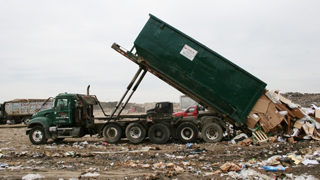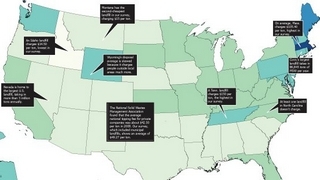Tipping fees vary across the U.S.
 If you’re looking for an inexpensive place to dump your trash, go to Idaho.
If you’re looking for an inexpensive place to dump your trash, go to Idaho.This is not to disparage Idahoans. But with an average landfill tipping fee rate of $18.43 per ton for municipal solid waste, the state has the cheapest disposal costs in the U.S., especially compared to Massachusetts’ average of $105.40 per ton, according to a Waste & Recycling News survey.
WRN asked some of the largest landfills in each state – public and private – how much it costs to dump one ton of municipal solid waste (MSW).
The gamut for disposal costs is wide and varied.
“If a public entity owns a landfill, they are required by law to establish that price, based on cost,” said Jeremy O’Brien, director of applied research for the Solid Waste Association of North America (SWANA). “Whereas, in the private sector, the company will set their price based on competition or lack thereof.”
In 2010, the most recent data available, there were 1,908 landfills in the U.S. compared to 7,924 in 1988, according to the U.S. EPA. The western U.S. had the largest number of landfills with 718; the South had 668; the Midwest had 394; and the Northeast had 128.
“As we’ve gone to regional landfills, a smaller number of landfills mean less competition,” O’Brien said. “We’ve built these larger facilities, but they’re more regional in nature so they have less local competition, if you will. The price is definitely driven by local, competing disposal facilities.”
The findings
Not surprisingly, based on the number of landfills, the top 10 states with the least expensive tipping fees are in the West and South: Idaho, Oregon, Colorado, Utah, Nevada, Nebraska, Montana, Louisiana, Arizona and Mississippi.
The most expensive states for landfills are primarily on the East Coast: Delaware, Tennessee, Hawaii, Washington, New Hampshire, Rhode Island, Pennsylvania, Vermont, Maine and Massachusetts.
 ”[ Tipping fees are] always higher near larger population centers,” said Ed Repa, director of environmental programs for the National Solid Wastes Management Association (NSWMA). “What you’ll find is that as you go from the East Coast, across the middle of the country and then back out to the West Coast, the tipping fees kind of go high, low, high. It’s really based on where you’re located at.”
”[ Tipping fees are] always higher near larger population centers,” said Ed Repa, director of environmental programs for the National Solid Wastes Management Association (NSWMA). “What you’ll find is that as you go from the East Coast, across the middle of the country and then back out to the West Coast, the tipping fees kind of go high, low, high. It’s really based on where you’re located at.”Another factor in the disparity of costs, Repa said, is whether there are resource recovery facilities in a particular area.
“What we’ve noticed in past surveys that we have done is that if there are resource recovery facilities, for instance, like in the Northeast and in Minnesota or places like that, the tipping fees tend to bump up just because they can,” Repa said. “If you’re the only guy in town and you charge $10 less than the $100 [it costs] at the [waste-to-energy] facility, then the waste is probably going to come to you and you’ll get the higher fee.”
Washington, at 66,455 square miles, or more than seven times the size of New Hampshire, is the only state on the West Coast that has comparable tipping fees ($72.97) to landfills on the East Coast – New Hampshire’s average fee being $74.63.
“There are a lot of legacy [post-closure] landfills that tipping fees are paying for on the west side [of Washington state],” said Peter Christiansen, section manager for the Washington Department of Ecology. “That’s a lot that’s incorporated into that cost. … It’s the old, closed landfills that have never gone away, and they still have to have the groundwater monitoring. Some are still under cleanup, and some still have gas issues. Post-closure fees and cleanup fees are a big part of it.”
In addition to the legacy landfills, tipping fees are used to help fund recycling programs, household hazardous waste collections and more aggressive waste reduction programs, Christiansen said.
Washington also exports about 2 million tons of its waste per year to neighboring Oregon, said Ellen Caywood, solid waste senior planner for the Washington Department of Ecology. Oregon has an average tipping fee of $25.41, according to WRN’s survey.
Tennessee also sticks out on the map (see pages 12-13) for having higher tipping fees than its neighbors.
Tennessee’s tipping fees averaged $71.79, about $35 more expensive than the states around it, according to WRN’s survey. Larry Christley, a program manager for Tennessee’s Department of Environment and Conservation, said the state’s tipping fees are closer to an average of $37 per ton when adding in all of the state’s 34 public and private landfills – not just analyzing the state’s largest landfills.
“I think some of the smaller [landfills] probably will pull that average down a little bit,” Christley said. “[But] I know that one of the larger ones, Middle Point, recently went up significantly when [its volume increased because] another local landfill closed for a period of time.”
Drilling down
From 1985 to 2008, tipping fees increased an average of $1.25 per year, according to NSWMA’s most recent data for private landfills. The national private landfill tipping fee average in 2008 was about $42.50. WRN’s 2012 national average for the largest public and private landfills is $49.27.
“If past history is an indication, tipping fees at landfills should continue to rise in the future at about $1.25 per year,” Repa said. “This is based on the regression analysis of existing data.”
Between 1987 and 1995, NSWMA found that private landfill tipping fees increased by $2.36 per year. Shortly after the 1991 enactment of Subtitle D of the Resource Conservation and Recovery Act, which set requirements for location, groundwater protection and monitoring of MSW landfills, tipping fees remained relatively constant.
Then from 2004 to 2008, tipping fees began to rise at a rate of $1.95 per year, which NSWMA attributed in part to fuel prices, insurance and other operating costs.
“My own feeling is that they they’re likely to continue to rise if there’s lack of regional competition in the marketplace,” O’Brien said. “If there’s no competing alternative, then what’s to prevent them from rising?”
You can return to the main Market News page, or press the Back button on your browser.

